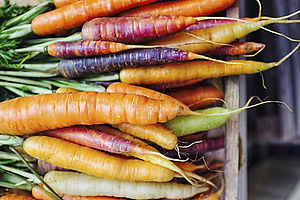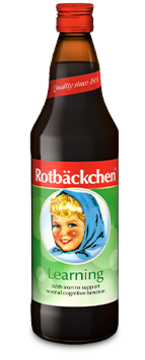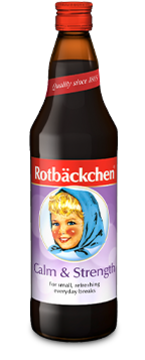Vitamin A
Vitamin A is also nicknamed the “eye vitamin”. This name is very truthful because it really helps to maintain vision. However, does much more. For example, the skin and immune system also rely on the help of vitamin A. Continue reading to find out what this vitamin can do for you and your family.
Table of Contents
What is vitamin A and beta-carotene?
 Like many other vitamins, vitamin A is an important part of a balanced diet and healthy lifestyle. Like vitamins E, D and K, this is a fat-soluble vitamin. This means that a small amount of fat is always needed for your body to absorb it properly. Food like liver, that have vitamin A and fat, have no problem. However, carrots should be eaten with a little oil, like in a raw vegetable salad. This way, your body can best absorb the vitamin A.
Like many other vitamins, vitamin A is an important part of a balanced diet and healthy lifestyle. Like vitamins E, D and K, this is a fat-soluble vitamin. This means that a small amount of fat is always needed for your body to absorb it properly. Food like liver, that have vitamin A and fat, have no problem. However, carrots should be eaten with a little oil, like in a raw vegetable salad. This way, your body can best absorb the vitamin A.
From a chemical perspective, vitamin A is not a single vitamin but a whole group of substance called retinoids. Retinol in particular is known by many people. Less so is “retinal”, “retinoic acids” and “retinyl palmitate”. Each of these belongs to vitamin A and has individual properties.
In addition to vitamin A, there are also precursors your body can convert into vitamin A. These are called provitamins. One of the best-known precursors is beta-carotene. It belongs to the carotenoid group and is just as valuable to your body as the other forms of vitamin A. In nature, beta carotene is found exclusively in plants.
Vitamin A – Effect in the body
Contrary to assumptions, vitamin A is more than just an eye vitamin, also contributing to:
- normal immune system function
- preservation of normal mucous membranes and skin
- normal iron metabolism
- cell specialisation functions
Daily requirements and dosage
![[Translate to Englisch:] Familie bereitet Salat mit Karotten und Pilzen zu [Translate to Englisch:] Familie bereitet Salat mit Karotten und Pilzen zu](https://www.rotbaeckchen.de/fileadmin/_processed_/8/7/csm_rotbaeckchen-vitamin-A-01_b097dbe220.jpg)
How much vitamin A does your body need? The Germany Society for Nutrition (DGE) recommends 0.8 mg of retinol per day for women and 1 mg for men to cover their daily vitamin A requirement. For children, the requirement is slightly lower – between 0.5 and 1 mg depending on age and gender. Youths between 13 and 18, pregnant women and breastfeeding women have slightly higher vitamin A requirements.
| Age | Retinol activity equivalent µg/day - Men | Retinol activity equivalent µg/day – Women |
|---|---|---|
| Children between 1 and 4 years | 300 µg | 300 µg |
| Children between 4 and 7 years | 350 µg | 350 µg |
| Children between 7 and 10 years | 450 µg | 450 µg |
| Children between 10 and 13 years | 600 µg | 600 µg |
| Youths between 13 and 15 years | 800 µg | 700 µg |
| Youths between 15 and 19 years | 950 µg | 800 µg |
| Adults between 19 and 65 years | 850 µg | 700 µg |
| 65 years and above | 800 µg | 700 µg |
| Pregnant women from 4 months | 800 µg | |
| Breastfeeding women | 1300 µg | |
Beta-carotene requirements are much higher. After all, the body still needs to convert it into vitamin A. Six milligrams of beta-carotene are needed to make one milligram of retinol.
In principle, you can easier cover your daily requirement with a healthy diet because vitamin A and the provitamin beta-carotene are found in many types of fruit and vegetables. A small piece of liver, a carrot or a portion of spinach usually covers your daily requirements. However, you should be careful not to cook food for too long, otherwise the vitamin content will be reduced. The same happens if food is exposed to light for too long because the vitamin decomposes. As best practice, store food in a dark place.
Because of good food supplies in Germany, vitamin A deficiency is rare. A deficiency usually occurs because of an eating disorder or a serious underlying disease, like liver damage or digestive disorders. If you want to prevent vitamin A deficiency, integrate vitamin A rich foods into your diet and give yourself a vitamin boost occasionally.
Food with vitamin A or beta-carotene
![[Translate to Englisch:] Kind und Mutter ernten Karotten [Translate to Englisch:] Kind und Mutter ernten Karotten](https://www.rotbaeckchen.de/fileadmin/_processed_/9/1/csm_rotbaeckchen-vitamin-A-04_4fe8aaf79d.jpg)
Vitamins and provitamins are components in many foods. Vitamin A is mainly found in liver and liver-containing animal products. Milk and eggs also contain vitamin A, but not as much. Beta-carotene is found in many yellow and orange fruits and vegetables, as well as dark leafy greens.
The following foods have among the highest vitamin A content. Vitamin A content is stated as “retinol equivalent”, meaning retinol, regardless of which vitamin A forms or carotenoids are contained.
| Food | Vitamin A per 100 g |
|---|---|
| Pork liver | 36 mg |
| Beef liver | 18 mg |
| Coarse sausage liver | 8.3 mg |
| Carrots | 1.5 mg |
| Sweet potato | 1.3 mg |
| Parsley | 0.87 mg |
| Kale | 0,86 mg |
| Spinach | 0.8 mg |
| Apricots | 0.28 mg |
| Eggs | 0.28 mg |
| Milk | 0.03 mg |
Average values according to Souci, Fachmann, Kraut: Food Composition and Nutrition Tables (7th ed.). Munich: C.H. Beck. 2008
By the way, beta-carotene is now found in many foods that would not otherwise naturally have it because it is added to many products as a natural colouring agent. Look for “E-numbers” for the additives “E 160” or “E 160 a”.
More about vitamins & nutrients

Vitamins & minerals
Want to know what all the valuable micronutrients do, what foods have them and how much you need?
Find out more
Vitamin B
The different members of the vitamin B complex perform different tasks – they take care of energy balance, the nervous system and many other processes in the body.
Find out more
Vitamin D
Vitamin D is the vitamin the body produces when from sunlight when going for a walk or outside on the balcony. It is involved in many processes in the body and is indispensable for young children – in fact, it is not really a vitamin.
Find out more

